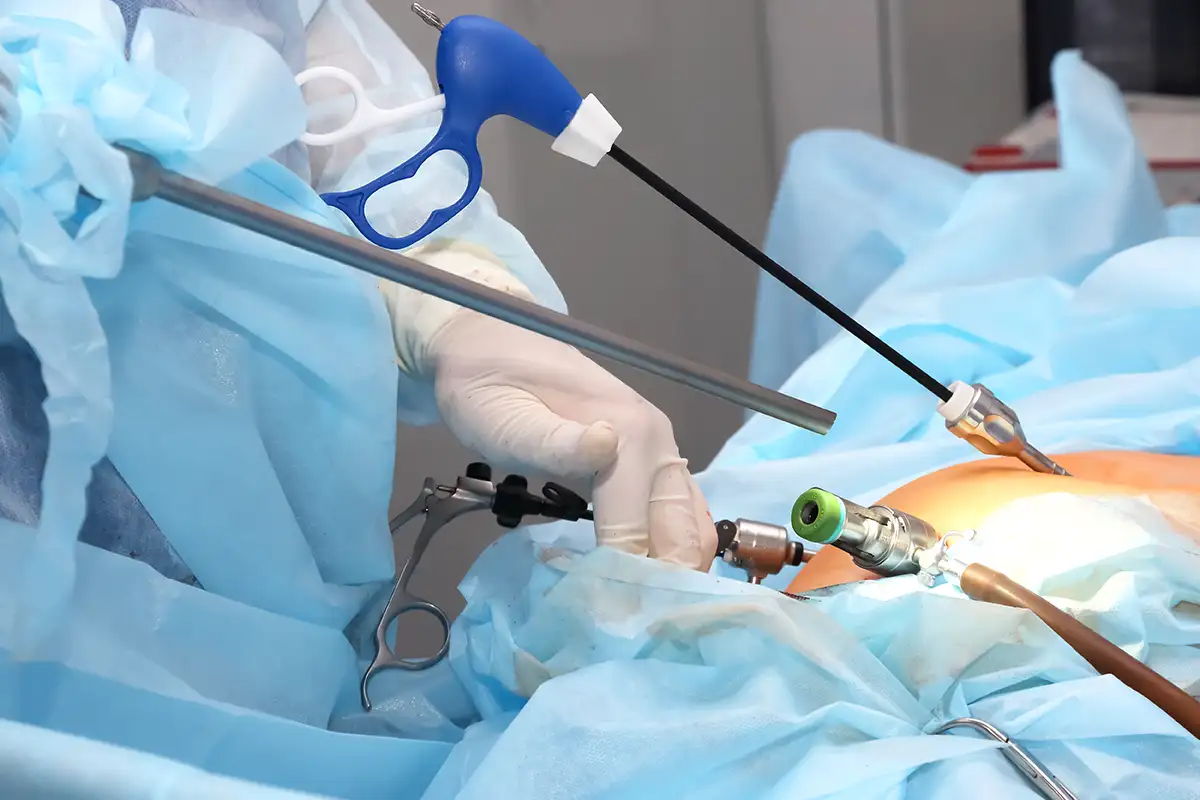Laparoscopic Hysterectomy in Mumbai Under Dr. Kavya's Guidance

Many women opt for a hysterectomy (uterus removal surgery) to get relief from menstrual problems, fibroids, endometriosis, pelvic inflammatory diseases, and other pelvic-related issues.
Traditional hysterectomy involves a large horizontal or vertical incision on your abdomen. The doctor removes the uterus through this cut and staples or stitches your abdomen.
Though many women still prefer traditional hysterectomy, it’s less common compared to the laparoscopic procedure.
If you are also considering a hysterectomy in Mumbai, meet Dr. Kavya Shetty — a board-certified laparoscopic gynec surgeon — to discuss the best hysterectomy procedure for your case.
Dr. Kavya will explain the procedure in detail, how you can prepare for it, and the recovery period. She’ll give you instructions for a quick and smooth recovery after laparoscopic surgery.
Dr. Kavya Shetty
If you have any questions regarding the surgery, feel free to contact Dr. Kavya and clear all your doubts before proceeding. She’ll assess your health and order a few tests to ensure you are a fit candidate for laparoscopic surgery.
Request Appointment Now
Hysterectomy: What Is It and When Is It Needed
Hysterectomy is a surgical procedure to remove a woman’s uterus (womb) with or without a cervix. Sometimes, the surgeon removes just the uterus, leaving the cervix in place. That’s called a subtotal hysterectomy.
Depending on the reasons you are considering this surgery, you may need to have the fallopian tubes, one or both ovaries and the surrounding tissues removed during a hysterectomy.
This is needed in patients with ovarian cancer, uterine cancer, or those at an increased risk of developing cancer later. If your ovaries are removed, you will enter menopause immediately.
As a gynecologist and Hysterectomy surgeon in Mumbai, Dr. Kavya will tell you how to cope with the menopause symptoms.
Hysterectomy is recommended when you have:
- Unexplained pelvic pain
- Heavy vaginal bleeding during and in-between menstrual cycles
- Endometriosis
- Fibroids
- Cancerous growth
- Hyperplasia
- Uterine rupture during childbirth
- Uterine prolapse
Hysterectomy reduces your risk of developing uterine cancer. If your cervix was removed during the procedure, you may no longer need pap smear tests.
Likewise, your risk of ovarian cancer is also eliminated if the surgeon has performed a total hysterectomy with bilateral salpingo-oophorectomy.

Understanding Laparoscopic Hysterectomy
Commonly called keyhole surgery, laparoscopic hysterectomy is a minimally invasive surgery that removes your uterus without a large abdominal incision.
Instead, the surgeon makes several small incisions to insert the instruments and remove the uterus either vaginally or abdominally. Let’s understand the procedure in detail:
How It’s Done
A laparoscopic hysterectomy is performed under general anesthesia. Once the anesthesia is administered, here’s what happens:
- The doctor will make multiple small incisions on your abdomen
- A laparoscope (a thin tube with a camera attached to the end) is inserted through one of these holes. This gives the surgeon a clear view of the internal organs.
- The surgeon inserts the surgical tools through other holes
- They will cut the uterus into small pieces for easy removal.
- The incisions will be sutured with dissolvable stitches.
Your doctor will carefully examine your other pelvic organs and perform an unplanned oophorectomy if they suspect a cancerous growth.
Recovery Period and Instructions
Dr. Kavya recommends a laparoscopic hysterectomy in Mumbai, as it’s less complicated than a traditional one and has a shorter recovery time. You can schedule follow-up appointments to monitor your health and receive post-surgical care instructions, including how to care for your wound, what to avoid, and when to begin work. Usually, women undergoing this minimally invasive surgery can resume their routine activities within 2-3 weeks. Here are some general instructions that most healthcare providers recommend for fast healing and quick overall recovery.
- Light spotting and bleeding after hysterectomy is normal. It will resolve on its own within six weeks.
- Avoid heavy lifting and strenuous physical exercises
- Avoid inserting anything into your vagina or having sexual intercourse for at least six weeks
- The strips on the cuts do not need manual removal. They will come off automatically. The internal stitches are dissolvable.
- You can shower and wash the incision site with soap and warm water.
- Ask someone to drive you home after surgery. You must avoid driving for 2-3 weeks or as long as you are taking painkillers.
- Do not get back to your routine chores immediately. You should start gradually and resume your regular work after a full recovery.
How Is Laparoscopic Hysterectomy Better Than Traditional Hysterectomy?
Laparoscopic Hysterectomy
- Laparoscopic surgery involves 0.5-1 cm incisions, which result in minimal scarring and are much less noticeable.
- It’s less painful and requires only a few pain relief medications.
- It involves a shorter recovery duration. The patient can go home within 24 hours.
- Due to its minimally invasive nature, laparoscopic hysterectomy is associated with a lesser risk of complications.
- There’s minimal blood loss
Traditional Hysterectomy
- Abdominal scars from traditional hysterectomy can be up to 12 inches long.
- It is more painful due to a large cut on the abdomen.
- A hospital stay for 3-5 days is needed.
- Open abdominal surgery increases the risk of infection around the incision site and hernia.
- It involves greater blood loss. Some patients might need a blood transfusion.a
While laparoscopic hysterectomy is better than traditional hysterectomy in all aspects, not everyone is a good candidate for the procedure. If you have an enlarged uterus, severe adhesions, and advanced-stage cancer, an open abdominal surgery might be more appropriate. As Laparoscopic Hysterectomy surgeon in Mumbai Dr. Kavya will thoroughly examine your condition and recommend the most suitable surgical procedure.
